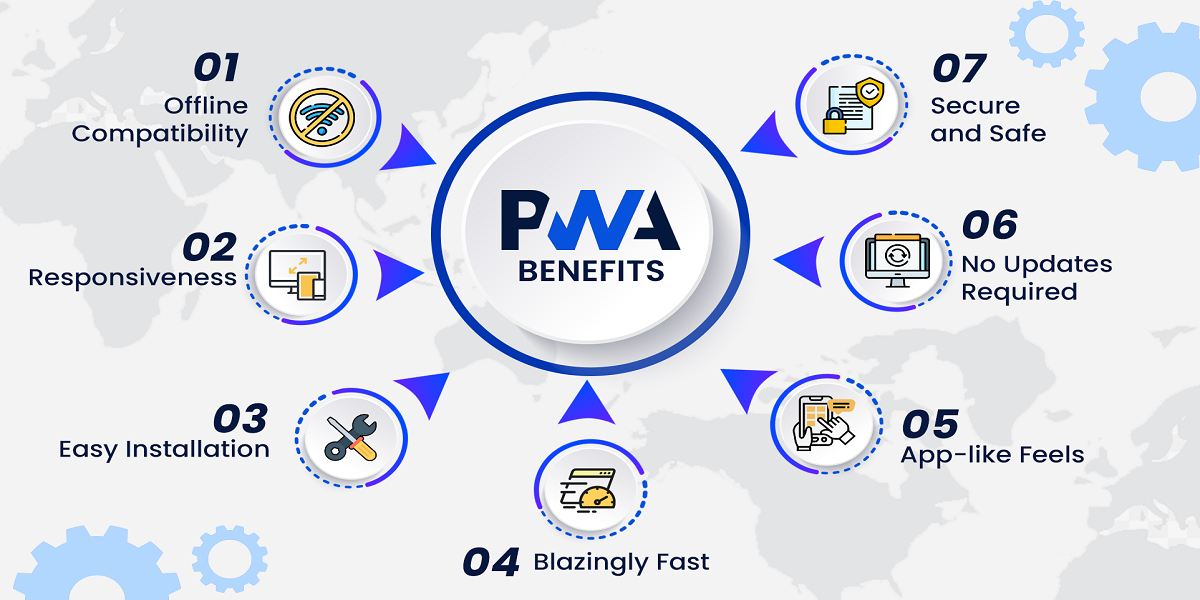
Today with people turning to smartphones over PCs, companies are reconsidering their digital approach to how to reach new audiences and enhance user experience. There have been instances where emerging markets have skipped the desktop version and moved straight to mobile experiences and some have both the web version and native apps for Android and iOS.
According to Statista reports the mobile sector is growing exponentially, with the number of mobile users expected to reach $7.49 billion worldwide by 2025. Therefore, to stay ahead of the curve and meet the rising expectation of mobile audiences, businesses and a web app development company must work in tandem to ensure their product offering is attractive, seamless, good interface, and offers a great user experience.
In the mobile vs web app debate, businesses are looking for options to provide a similar, native-like appearance on all devices. And the solution they have come up with lies in creating Progressive Web Applications (PWAs).
Progressive Web Applications(PWAs) are the future of the web.
Google introduced Progressive Web Applications (PWAs) back in 2015 as an app development approach written to run inside a web browser. They look and feel like native apps where users can add the app to their home screen and begin using it. First impressions matter and a PWA helps provide a fast and smooth user experience. Simply put, a PWA is a hybrid solution that combines and leverages the features of both a website and a mobile app.
The numbers don’t lie. Companies that have adapted and built PWAs for their website have seen impressive results.
For example
Twitter developed Twitter Lite to provide customers with a robust experience, quick loading, and better engagement with lower data consumption. As a result, it saw 75% more tweets, a 65% increase in page per session, and a 20% decrease in bounce rates after it switched over to PWA technology.
Hulu saw a rise of 27% in returning visitors when they moved from platform-specific experience to PWA.
Forbes also saw an increase of 100% engagement after they launched a PWA.
Some other famous examples of Progressive Web Apps are Pinterest, Alibaba, Facebook, Uber, Telegram, Tinder, Walmart, Target, Macy’s, etc.
Benefits of a PWA over a mobile app
PWAs are truly the future of web applications, and the following are some features and benefits it offers for good business growth and better productivity.
Offline Compatibility: PWAs can function even when users are offline and have less/no connectivity. Meaning they can continue using the app without interruptions.
Responsiveness: A PWA can work on any device, be it a mobile, tablet, or desktop, and it looks uniform throughout, leading to a good user experience.
Easy Installations: Users can visit your website and add the app to their home screen without visiting any app store to download the app.
Blazingly Fast: Offers fast loading time, reducing abandonment and more engagement.
App-like Feel: It works and looks just like a native app with a website-like performance. It is easy to build too.
No Updates Required: Automatic updates are done on the app, and users can get the latest content and functionalities without going through the manual update process.
Secure and Safe- Data is secure as it loads over an HTTPS connection eliminating security breaches, snooping, or illegal activity risks.
PWAs or Native mobile apps for your business: What’s better?
Your customers are the most critical asset for the growth of your business. As most consumers expect instant, anything otherwise will make them lose interest and perhaps not use your app. The type of business, the idea you have, the features you wish to include, the target audience, and the revenue model add up to the decision you to choose between a mobile app and a web app.
You can easily convert your website to a Progressive Web Application (PWA) and bring in the required reach, discoverability, native-like features, and ubiquity you need from the app. They can pull in your need's organic traffic and impress first-time visitors with a sleek and fast experience. Easy installation options also solve the issue of limited device storage space.
Wrapping Up
We hope this blog gave you a detailed insight into a PWA that can help you make an informed decision. PWAs are an in thing with several businesses adopting them at different stages of their product journey. Its universal appeal, convenience, ease of developing and deploying make it tick. It also promises excellent conversions and user engagement which is a huge plus.
Making the right app development decision for your business is crucial and mustn’t be rushed, and ensure you weigh the pros and cons before your move on to development. PWAs are gaining momentum worldwide, and companies can opt for them to stay ahead of the competition.
Native or regular mobile apps have issues like high data consumption, storage space, development cost, internet connectivity, and more. PWAs help eliminates all these issues by delivering a good user experience, cost-efficient, cross-platform access, higher accessibility, and discoverability on the web.
